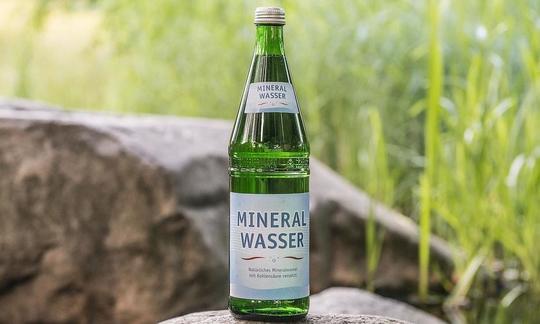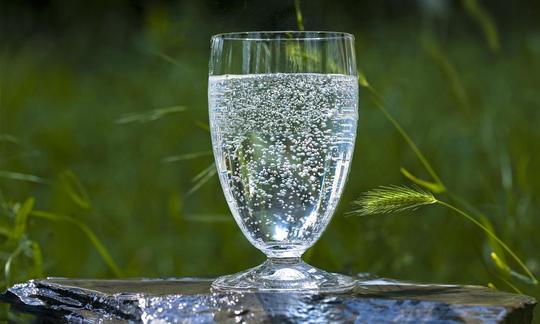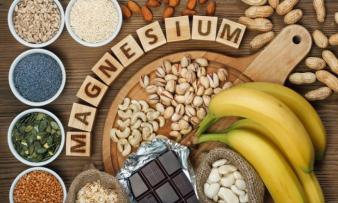Table of contents
Carbonated mineral water is water from a mineral spring that contains a variety of minerals, salts and sulphur components. Naturally raw, it can be "naturally" sparkling depending on the gases it contains. Organic mineral water cannot be certified by the state.
Use in the kitchen
Carbonated mineral water is also called sparkling water, although a distinction must be made between carbonated mineral water from natural sources and mineral water with artificially added carbon dioxide. Carbonic acid is only created when carbon dioxide combines with water. The carbon dioxide content is usually the only difference to still mineral water, although the composition of the minerals it contains can vary considerably depending on the source. Sparkling water is generally used as an alternative to soft drinks or alcoholic beverages. So-called infused water is popular, and is particularly refreshing in summer thanks to the addition of fruit or small amounts of fruit juice. Try a combination with a mix of three ingredients each, such as strawberries, lemon and basil, watermelon, jalapeño and peppermint, or mango, coconut and lime. You can also use carbonated mineral water for cooking and baking.
Highly carbonated mineral water can be used as a substitute for oil and fat when frying. To do this, you can just cover the bottom of the pan you are using with water. As soon as the water foams, add the tofu, for example, and fry at medium to high heat. As the water evaporates, keep adding a little bit of mineral water with a tablespoon of mineral water, but without boiling the ingredient in the water. When steaming or boiling vegetables, you can use it to add additional mineralization to the dish. It also ensures that steamed vegetables remain crisper and retain their color. As an ingredient in pastries such as vegan pancakes or waffles, it helps to give them a fluffy consistency. It can make soups and sauces creamier and make whipped cream or crème fraîche unnecessary. This allows you to save calories without sacrificing flavor. You can even replace some of the oil used with carbonated mineral water when making salad dressings.
Preparation yourself
You can use so-called water carbonators to add carbon dioxide to mineral water or tap water yourself. Please note that reusable bottles are often home to pathogens that are harmless to healthy people but can pose a risk of infection to immunocompromised people. 1 It is best to clean the bottles after each use with warm water and a bottle brush. When not in use, you should store the bottles dry, with the lid unscrewed and upside down, and avoid drinking directly from the bottle. 2 The colder the water, the more carbon dioxide it can absorb. 4
Vegan recipe for pancakes with sparkling water
Ingredients (for 4 people): 300 g wheat flour, 450 ml plant milk (e.g. oat milk), 1 pinch of salt, 1 pinch of sugar, 4 tbsp carbonated mineral water, rapeseed oil (refined).
Preparation: Put the flour, plant milk, salt, sugar and mineral water in a bowl and mix with a whisk or hand mixer until you have a smooth dough. Let the dough rest for about 30 minutes. Heat some rapeseed oil in a pan. Pour the dough into the pan in portions and bake small pancakes. Serve vegan pancakes with fresh fruit or other toppings as desired.
Infused water with sparkling water
Ingredients (for 2 persons): 1 orange, 20 g grapes (red), 1 sprig of fresh rosemary.
Preparation: Cut the orange into thin rings and halve the grapes. Put both, together with the rosemary, in two glasses or a large jug and then pour in the sparkling mineral water. Place it in the fridge before enjoying or leave it at room temperature for a few minutes so that the water can absorb the flavor of the fruit and herbs.
Vegan recipes with mineral water (carbonated) can be found under the note: " Recipes that have the most of this ingredient ".
| Not only vegans or vegetarians should read this: Vegans often eat unhealthily. Avoidable nutritional errors. |
Purchasing - Storage
You can find carbonated mineral water at major retailers such as Coop, Migros, Denner, Volg, Spar, Aldi, Lidl, Rewe, Edeka, Hofer, Billa as well as in organic supermarkets such as Denn's Biomarkt and Alnatura in plastic or glass bottles.
There is currently no state organic seal for mineral water. In Germany, there are two private seals that, according to the Federal Court of Justice, require higher standards than for conventional mineral water. In addition, additional criteria for environmental protection and sustainability must be met. 3
The availability of carbonated mineral water varies depending on the size of the store, catchment area, etc. Our recorded food prices for the DA-CH countries can be found above under the ingredients image - and by clicking you can see their development at various suppliers.
Storage tips
Sun and heat can affect the quality of mineral water. Mineral water in green (glass) bottles is somewhat better protected from light than in light containers. Acetaldehyde contained in PET bottles can dissolve and pass into the drink if exposed to strong light, affecting the taste and smell of the water undesirably. Store the bottle of carbonated mineral water in a clean, dry, cool place, protected from light and odorless. Glass bottles in particular guarantee an unchanged taste for several years. The carbon dioxide contained in mineral water bottled in PET bottles can escape over time. Also note the expiration date for PET bottles. 4
Ingredients - Nutritional values - Calories
Depending on the type of rock layer through which the water flows, each liter of mineral water contains between 500 and 2000 mg of minerals and trace elements (Switzerland). Calcium, magnesium, sodium, chloride, sulfate, hydrogen carbonate, various trace elements and carbonic acid are usually present. 5
In the data available to us ( USDA) 1 liter of mineral water contains approximately 330 mg calcium (covers 40% of the daily requirement), 110 mg magnesium (30%), 130 mg sodium (20%) and 20 mg potassium. Iron, phosphorus and zinc are not present in any measurable quantities. 24
Is there mineral water with iodine? As a rule, natural mineral water contains only very small amounts of iodine. 6 However, there are springs, such as Ruhpolding (DE), whose mineral waters contain higher amounts of iodine. 7
The complete ingredients of mineral water (carbonated), the coverage of the daily requirement and comparison values with other ingredients can be found in our nutrient tables. In the article Nutrients explained you will get a detailed insight into the topic.
Health Benefits
Water helps restore fluids lost through metabolism, breathing, sweating and excretion. It protects against overheating, lubricates joints and tissues, maintains healthy skin and is necessary for good digestion. It is also the perfect calorie-free drink to quench thirst and rehydrate the body. 8
Water is essential for cellular homeostasis and life. Total water intake includes drinking water, water in beverages, and water contained in food. Although low total water intake has been associated with some chronic diseases, this evidence is insufficient to establish recommendations for water intake as a means of reducing the risk of chronic diseases. Instead, adequate total water intake is recommended to prevent harmful, particularly acute, effects of dehydration, which include disturbances in metabolism and other bodily functions. The amount needed depends on age, gender, physical activity, and ambient temperature. Over the course of a few hours, a water deficit in the body can occur due to reduced intake or increased water loss due to physical activity and environmental factors (e.g. heat). In everyday life, however, fluid intake, determined by the combination of thirst and consumption of beverages with meals, allows hydration status and total water levels to be maintained at normal levels. Since healthy people have a significant ability to excrete excess water and thus maintain water balance, no maximum permissible amount of water has been established. However, there are documented cases of acute water toxicity resulting from rapid ingestion of large amounts of fluid that far exceed the maximum renal excretion rate of about 0.7 to 1 l/hour. 9
In the USA, carbonated mineral water is on the list of foods with low nutritional value and is not sufficient on its own to meet the need for essential minerals. 10 However, some mineral waters contain higher amounts of calcium, which theoretically cover the entire daily requirement with two liters. 6
Is carbonated mineral water harmful for gout? There is no evidence that carbonated mineral water has any effect on an existing case of gout (arthritis urica). In gout, uric acid crystals are deposited in the tissue, which can lead to severe pain. 11 The human body excretes carbonic acid in the form of carbon dioxide through breathing and is not involved in hyperacidity. 12
Secondary plant substances
Secondary plant substances are not relevant to the nutrient profile of carbonated mineral water. Find out more about the importance and classification of these bioactive substances in food in the article on secondary plant substances.
Dangers - Intolerances - Side effects
Drinking sparkling water can lead to gas formation and flatulence, the severity of which varies from person to person.
Is carbonic acid unhealthy? There are numerous myths surrounding the drinking of carbonated mineral water, which Öko-Test cleared up in a 2021 article. In contrast to citric acid or phosphoric acid (e.g. in cola drinks), carbonic acid is not an erosive acid that attacks tooth enamel. Carbonic acid (H 2 CO 3) is also very unstable and quickly decomposes in the air to carbon dioxide (CO 2) and water (H 2 O). Still mineral water or tap water has a pH value of around 7 and is therefore chemically neutral. Due to the carbon dioxide it contains, sparkling water with a pH value of around 5.5 is chemically slightly acidic, which is why naturopathic practitioners tend to advise against drinking it. Due to the instability of the carbonic acid, you breathe out the carbon dioxide, which is why carbonated mineral water does not contribute to over-acidification of the body. Large amounts can lead to belching or other stomach problems, such as gas formation and flatulence. People with a sensitive stomach are therefore advised to drink water with a high proportion of hydrogen carbonate (salts of carbonic acid) instead. These can neutralize excess acids. There are also no well-founded studies on the theory that carbonated water makes you fat and makes losing weight more difficult. 12
According to the German Federal Office for Radiation Protection, German mineral water and natural mineral waters in general always contain naturally occurring radioactive substances (radon-222, radium-226, radium-228 and uranium), although in most cases the amount is small and harmless to humans. However, it can happen that mineral water exceeds the prescribed maximum dose and measures are required to reduce the radioactive substances. 13
Ecological footprint - animal welfare
The ecological footprint of a food depends on various factors. The type of agricultural production (conventional vs. organic), seasonal, regional or domestic production or import by truck, ship or plane, different types of packaging and whether the goods are fresh or frozen all play a decisive role. 14
One kg (1 litre) of carbonated water (glass bottle) is calculated with a CO 2 balance of 0.19 kg CO 2 eq/kg, although the value varies from manufacturer to manufacturer. 15
A study conducted in Switzerland in 2014 compared the environmental impact of drinking water with that of mineral water and other beverages. The study concluded that drinking water (or tap water) causes the least environmental impact. Uncooled, still water causes 450 times less environmental impact than mineral water. When consuming carbonated mineral water, transport and bottle production are the main factors contributing to the overall environmental impact. However, using a soda machine can significantly reduce this, but only if the machine produces more than one liter of sparkling water a day for at least five years. The origin of the mineral water (proximity to the bottling site) and thus the transport routes account for a significant proportion of the environmental impact. It should be noted, however, that replacing mineral water with drinking water would only save around 0.3% of the overall environmental impact of consumption. Much higher reduction potential is apparent, for example, in the heating of water in the home. In addition, one should not forget that the situation in other countries, with polluted water and higher costs for the provision of drinking water, looks different and generates different values. 16
For detailed explanations of various sustainability indicators (such as ecological footprint, CO2 footprint, water footprint), see our article: What does the ecological footprint mean?.
Worldwide occurrence - cultivation
There are sources of mineral water worldwide. In Switzerland, mineral water comes from over 20 natural springs. 17
The Federal Department of Home Affairs ( FDHA) of Switzerland describes natural mineral water as microbiologically impeccable water. It is extracted from an underground layer or deposit and from one or more springs, which in turn are accessed via one or more natural or artificial outlets. It must also be characterized by a special geological origin, type and quantity of mineral components, original purity and a composition, temperature and outflow that remain consistent within the framework of natural fluctuations. This must be proven by scientifically recognized methods. Manufacturers can add additional carbon dioxide to mineral water, but must label this accordingly on the bottle. If the water contains more than 250 mg/l of free, spring-derived carbon dioxide, it can be described as "acidic" or "acidic spring". 18
Further information
The Information Centre for German Mineral Water ( IDM) states that there are various types of water. In addition to natural mineral water, a distinction is made between medicinal water, spring water, table water and drinking water (tap water). 19
According to the Federal Office for Food Safety and Veterinary Affairs ( FSVO), drinking water is the foodstuff most strictly monitored by the cantonal authorities in Switzerland. 20 In Germany 21 and Austria 22, the Drinking Water Ordinance also regulates the quality of drinking water, whereby drinking water suppliers must ensure the appropriate quality up to the water meter and the owners of the house from there to the tap. Drinking water comes in large quantities mostly from rivers, lakes or dams (reservoirs) and goes through important steps of cleaning, disinfection and changes in composition before use. In addition to drinking, it is also used for cooking, cleaning, washing, personal hygiene and flushing the toilet. 19
Medicinal water must also come from underground and clean springs. Bottling also takes place directly at the source and is officially recognized. In contrast to natural mineral water, it is subject to the Medicines Act and, due to its mineral composition, has scientifically proven preventive, soothing or healing properties. Spring water also comes from underground water sources. Bottling is not officially recognized, but must take place at the source. Spring water must meet the requirements of drinking water in terms of its composition, but is not subject to such high purity requirements as natural mineral water. Table water is produced industrially and can consist of various types of water (drinking water, mineral water, natural brine, sea water) to which additional minerals or carbon dioxide have been added. The same purity requirements apply as for drinking water, but there are no legal regulations for the mixing ratios. 19
Carbonic acid makes the water last longer because it reduces the oxygen content, which is essential for the survival of bacteria. 12
Alternative names
Mineral water with carbonic acid is also called Sprudelwasser or, predominantly in Germany, Selterswasser. In English it is called "carbonated water", "sparkling water", "soda water", "bubbly water", "fizzy water", "club soda", "water with gas" or, especially in the USA, "seltzer water", which refers to the German Selterswasser.
Other applications
Can you use mineral water for plants? You can use carbonated mineral water to water your plants without any problem. However, plants will only get a small benefit from it. It is much more important that the water does not contain chlorine, has little lime and is not too acidic or too cold. 23
Bibliography - 24 Sources
| 1. | Kohnen W, Teske-Keiser S et al. Microbiological quality of carbonated drinking water produced with in-home carbonation systems. International Journal of Hygiene and Environmental Health. 2005;208(5):415–423. |
| 2. | SRF Schweizer Radio und Fernsehen. Wassersprudler im Test: Nicht alle sind prickelnd. 2018. |
| 3. | Verbraucherzentrale Hamburg. Was steckt hinter Bio-Mineralwasser und sollte man das kaufen? 2023. |
| 4. | Bundeszentrum für Ernährung. Wasser: Zubereitung und Lagerung. Trinkwasserfilter meist unnötig, Mineralwasser richtig lagern. 2023. |
| 5. | SMS Verband Schweizerischer Mineralquellen und Soft-Drink-Produzenten. Mineralien: Mineralstoffe und Spurenelemente. |
| 6. | SMS Verband Schweizerischer Mineralquellen und Soft-Drink-Produzenten. Mineralisierungstabelle Schweiz. 2014. |
| 7. | St. Leonards Quellen: Die natürliche Jodquelle. |
| 8. | Harvard T.H. Chan. School of Public Health. The Nutrition Source - Water. |
| 9. | Institute of Medicine. Water. In: Institute of Medicine, Hrsg. Dietary Reference Intakes for Water, Potassium, Sodium, Chloride, and Sulfate. Washington, DC: The National Academies Press; 2005: 73–185. |
| 10. | USDA United States Department of Agriculture. Foods of Minimal Nutritional Value. |
| 11. | Deutsche Heilbrunnen. Gicht und Harnsäure. |
| 12. | Öko-Test de: Ist Wasser mit Kohlensäure ungesund? 4 Mythen rund um Sprudelwasser. 2021. |
| 13. | BfS Bundesamt für Strahlenschutz. Natürliche Radionuklide in Mineralwässern. 2023. |
| 14. | Reinhardt G, Gärtner S, Wagner T. Ökologische Fussabdrücke von Lebensmitteln und Gerichten in Deutschland. IFEU Institut für Energie- und Umweltforschung Heidelberg. 2020:1-22. |
| 15. | Concito. Denmark's green think tank. The big Climate Database. Version 1. Water, carbonated, glass bottle. |
| 16. | Jungbluth N, König A, Keller R. Ökobilanz Trinkwasser: Analyse und Vergleich mit Mineralwasser sowie anderen Getränken. Aqua & Gas. 2014. |
| 17. | SMS Verband Schweizerischer Mineralquellen und Soft-Drink-Produzenten. Geschichte: Ursprünglichkeit und Natürlichkeit. |
| 18. | EDI Eidgenössisches Departement des Innern. 817.022.12. Verordnung des EDI über Getränke. 2020. |
| 19. | Mineralwasser com: Wasser ist nicht gleich Wasser: Welche Wasserarten gibt es? |
| 20. | BLV Bundesamt für Lebensmittelsicherheit und Veterinärwesen. Trinkwasser. 2022. |
| 21. | Bundesgesetzblatt. Zweite Verordnung zur Novellierung der Trinkwasserverordnung Nr. 159. 2023. |
| 22. | Bundesministerium Soziales, Gesundheit, Pflege und Konsumentenschutz. Gesamte Rechtsvorschrift für Trinkwasserverordnung, Fassung vom 10.01.2018. |
| 23. | Garten-Lexikon de: Pflanzen mit Mineralwasser und Sprudelwasser giessen? |
| 24. | USDA United States Deparment of Agriculture. Nährwertdatenbank. |













Comments